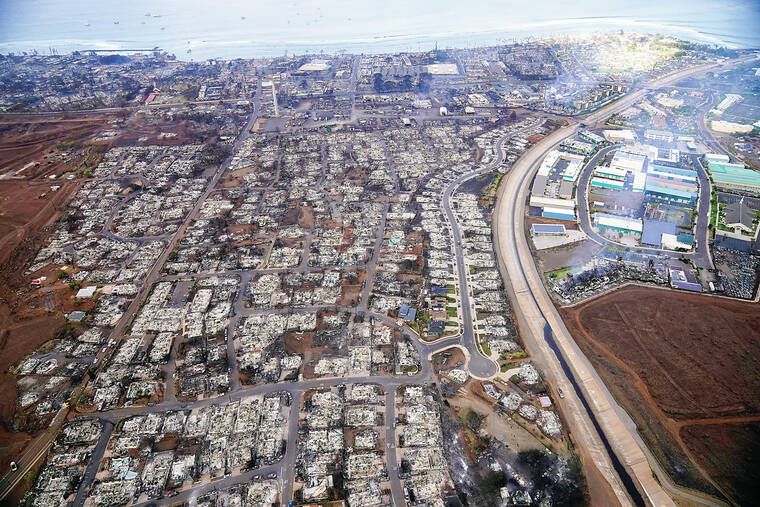UPDATE: President Biden to visit Maui on Monday; death toll rises to 110
UPDATE: 2 p.m.
Gov. Josh Green this afternoon said the confirmed death toll in the Lahaina wildfires has reached 110, up four from Tuesday.
ADVERTISING
UPDATE: 10:40 a.m.
President Joe Biden and First Lady Jill Biden will visit Maui on Monday to observe the impact of the deadly fires and to discuss the next steps in the recovery efforts.
While on the ground, the president, first lady and Gov. Josh Green will meet with first responders, survivors and federal, state and local officials.
Green extended an invitation to the president after being advised that the search and recovery efforts will have reached a point that a visit can be done safely, according to a press release from Green’s office.
“The suffering experienced as a result of the fires on Maui is a tragic blow to our state and the people of Hawaii,” Green said in the press release. “However, we have been uplifted by the outpouring of support we have received from across our communities, across the nation, and throughout the world.
“We are especially grateful to President Biden for his strong support and partnership. From the first hours of the tragedy, he has enabled us to respond with the full force of the resources we need.”
PREVIOUSLY
The Hawaii Tourism Authority is requesting that the governor declare a tourism emergency in the wake of devastating wildfires in Maui and Hawaii counties, and if approved it would be the first such declaration and allow the agency to tap into a $5 million special fund.
A state law allows the HTA board to request the governor to declare a tourism emergency if a recent catastrophic event “adversely affects Hawaii’s tourism industry by resulting in a substantial interruption in the commerce of the state and adversely affecting the welfare of its people.”
If Gov. Josh Green approves HTA’s request, it would be the first time that the state law has been used to declare a tourism emergency.
Green’s approval would give HTA the ability to tap into a $5 million emergency special tourism fund.
“Prioritizing the use of these assets effectively is critical to HTA’s short-term response to the emergency, and longer-term implications for the state, its economy and its people,” HTA Chief Administrative Officer Daniel Naho‘opi‘i said.
While the cost to human life is the gravest impact of the wildfires, preliminary analysis from the state Department of Business Economic Development and Tourism anticipates significant compounding economic losses statewide from lost business operations and reductions in visitors.
Per-day losses include: $8.5 million in total sales revenues; $2.9 million in household income; $1.05 million in direct visitor spending; $1.96 million in lost sales with multiplier effects; $535,500 in household income; $414,000 in state revenue; and $121,800 in state taxes.
“For the loss from business operations, the sale revenue loss is statewide since Lahaina businesses did need to purchase supplies from other parts of the state,” said Eugene Tian, chief state economist. “Household income is also statewide, tax revenues are statewide as well.”
Tian said as many as 10,000 direct jobs also have been lost in Lahaina for the period that businesses are not in operation.
Naho‘opi‘i said if Green approves HTA’s emergency tourism declaration, HTA has established a permitted interaction group to come up with a plan to deploy HTA resources, which could include money from the $5 million emergency special tourism fund if warranted.
HTA board members appointed to the permitted interaction group include Mahina Paishon-Duarte, Sherry Menor-McNamara, Mufi Hannemann, Mike White and David Arakawa.
Naho‘opi‘i said their recommendations could run the gamut from providing technical support for communities, businesses and employees to workforce development. He said shoring up Hawaii’s tourism brand and working with partners such as airlines also could be part of the recovery phase, which will follow current crisis management.
Hannemann said a current focus has to be getting out the message that only West Maui is closed to tourism.
“In addition to telling what areas are taboo, we need to tell visitors where they can go on Maui, and that Wailea, Kihei, Makena and other places are open,” Hannemann said. “We had federal funding during COVID to keep people at home, but right now we need federal funding to keep people at work. Imagine losing your home and your job.”
Naho‘opi‘i said HTA has faced other tourism emergencies in the past. He said during the Great Recession, state law did not allow use of the emergency special tourism fund for economic disasters and HTA was able to tap into a $10 million marketing opportunity fund to support co-ops with airlines and wholesalers, and added marketing efforts in the U.S. West Coast and Japan.
Naho‘opi‘i said HTA also considered taking action to assist with the Kauai flood, but ultimately had enough funds available without taking that route.
The HTA board also sought a COVID-19 tourism emergency on May 28, 2020; however, in that situation Gov. David Ige did not approve the request. Ultimately, Hawaii and other states received billions in federal funding to address the impacts of COVID-19, which in the earliest days collapsed Hawaii’s visitor industry.


